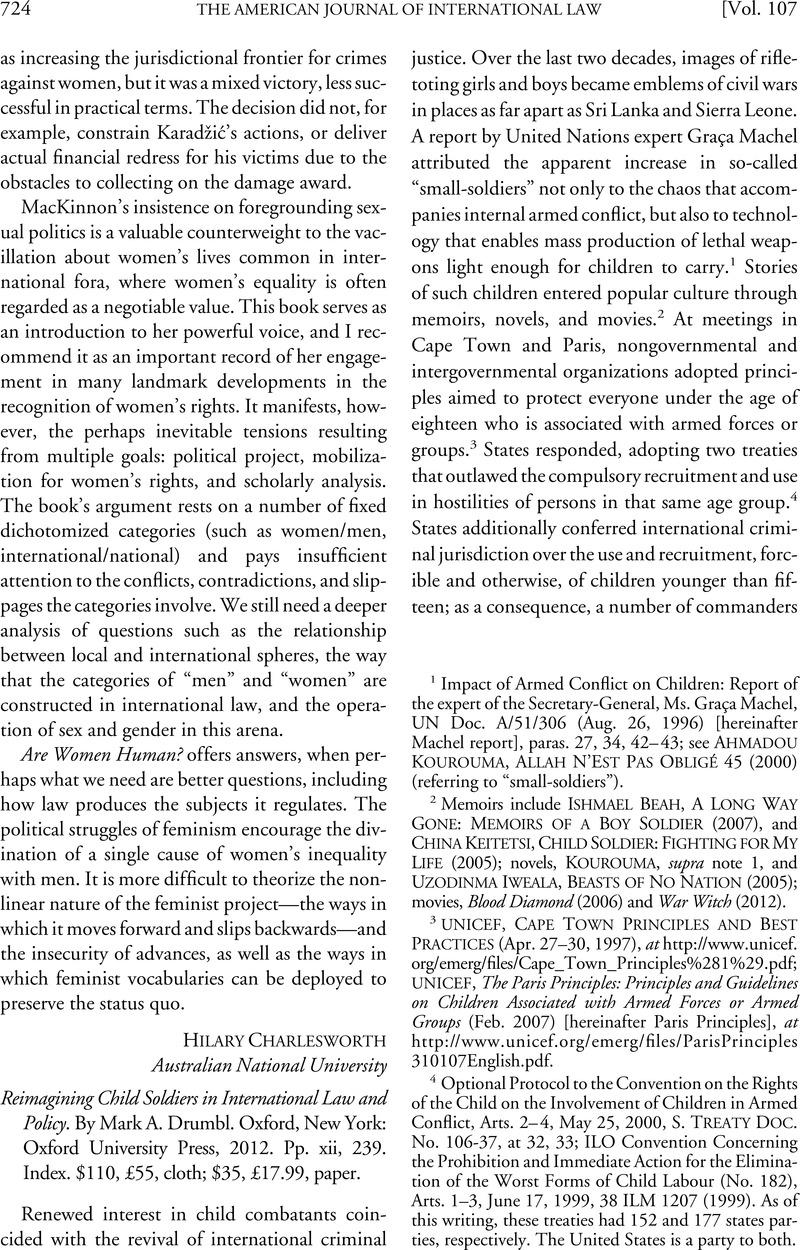Article contents
Reimagining Child Soldiers in International Law and Policy. By Mark A. Drumbl. Oxford, New York: Oxford University Press, 2012. Pp. xii, 239. Index. $110, £55, cloth; $35, £17.99, paper.
Published online by Cambridge University Press: 20 January 2017
Abstract

- Type
- Recent Books on International Law
- Information
- Copyright
- Copyright © American Society of International Law 2013
References
1 Impact of Armed Conflict on Children: Report of the expert of the Secretary-General, Ms. Graça Machel, UN Doc. A/51/306 (Aug. 26, 1996) [hereinafter Machel report], paras. 27, 34, 42–43; see Kourouma, Ahmadou, Allah N’est Pas Obligé 45 (2000)Google Scholar (referring to “small-soldiers”).
2 Memoirs include IshmAel Beah, A Long Way Gone: Memoirs of A Boy Soldier (2007), And China Keitetsi, Child Soldier:Fighting for My Life (2005); Novels, Kourouma, Supra Note 1, And Uzodinma Iweala, Beasts of No Nation (2005); Movies, Blood Diamond (2006) And War Witch (2012).
3 Unicef, Cape Town Principles and Best Practices (Apr. 27–30, 1997), at Http://Www.Unicef.Org/Emerg/Files/Cape_Town_Principles%281%29.Pdf; Unicef, The Paris Principles: Principles and Guidelines on Children Associated with Armed Forces or Armed Groups (Feb. 2007) [hereinafter Paris Principles], at http://www.unicef.org/emerg/files/ParisPrinciples310107English.pdf.
4 Optional Protocol to the Convention on the Rights of the Child on the Involvement of Children in Armed Conflict, Arts. 2–4, May 25, 2000, S. Treaty Doc. No. 106-37, at 32, 33; ILO Convention Concerning the Prohibition and Immediate Action for the Elimination of the Worst Forms of Child Labour (No. 182), Arts. 1–3, June 17, 1999, 38 ILM 1207 (1999). As of this writing, these treaties had 152 and 177 states par ties, respectively. The United States is a party to both.
5 Convictions for child-soldiering in violation of Article 4(c) of the Statute of the Special Court for Sierra Leone were affirmed against rebel leaders in Prosecutor v. Sesay, Case No. SCSL-04-15-A, Appeals Judgment (Oct. 26, 2009) and Prosecutor v. Brima, Case No. SCSL-2004-16-A, Appeals Judgment (Feb. 22, 2008) (reported by Valerie Oosterveld at 103 AJIL 103 (2009)).At this writing, appeal is pending in Prosecutor v. Taylor, Case No. SCSL-03-01-T, Trial Judgment (May 18, 2012), by which the former president of Liberia was convicted on similar counts. Also on appeal are verdicts pertaining to two Congolese militia leaders charged under Art. 8(2)(e)(vii) of the Rome Statute of the International Criminal Court, July 17, 1998, 2187 UNTS 3 (hereinafter Rome Statute): the conviction in Prosecutor v. Lubanga, Case No. ICC-01/04-01/06, Judgment Pursuant to Article 74 of the Statute (Mar. 14, 2012) (reported by Diane Marie Amann at 106 AJIL 809 (2012)), and the acquittal in Prosecutor v. Ngudjolo, Case No. ICC-01/04-02/12, Jugement rendu en application de l’article 74 du Statut (Dec. 18, 2012). Cited documents from these courts are available at http://www.sc-sl.org and http://www.icc-cpi.int, respectively.
6 “Omar Khadr as a child soldier, is a victim,” read the subhead of a brief whose signatories included present and former foreign ministers and International and national judges, as well as the former chief prosecutor for the Special Court for Sierra Leone. Amicus Curiae Brief filed by McKenzie Livingston, Esq. on Behalf of Sen. Robert Badinter, et al. at 6, United States v. Khadr, (Jan. 18, 2008), at http://www.law.utoronto.ca/documents/Mackin/khadr_Amicus_Badinter.pdf. see Paul Koring, Khadr to Appeal War Crimes Convictions, Globe & Mail, Apr. 27, 2013, at A5 (reporting on Khadr’s decision to challenge, in light of subsequent federal appellate decisions, his 2010 conviction by guilty plea).
7 see Charles Taylor, Modern Social Imaginaries 23 (2004) (outlining, in a work by a noted Canadian philosopher, a concept of “social imaginary” akin to Drumbl’s definition of “imagination”).
8 see Warrant of Arrest for Joseph Kony Issued on 8 July 2005 As Amended on 27 September 2005, Prosecutor v. Kony et al., Case No. ICC-02/04-01/05-53 (Sept. 27, 2005).
9 Paris Principles, supra note 3.
10 see United Nations, Zero Under 18, http://childrenandarmedconflict.un.org/our-work/zero-under-18-campaign (May 6, 2013); see also Child Soldiers International, Straight-18, http://www.child-soldiers.org/theme_reader.php?id=1 (visited July 30, 2013).
11 see Rome Statute, supra note 5, Art. 26 (“The Court shall have no jurisdiction over any person who was under the age of 18 at the time of the alleged commission of a crime.”).
12 E.g., Huneeus, Alexandra, International Criminal Law by Other Means: The Quasi-Criminal Jurisdiction of the Human Rights Courts, 107 AJIL 1 (2013)Google Scholar; King, Elizabeth B. Ludwin, Does Justice Always Require Prosecution? The International Criminal Court and Transitional Justice Measures, 45 Geo. Wash. Int’l L. Rev. 85 (2013)Google Scholar.
13 Cf. Machel report, supra note 1, para. 43 (allowing that adult combatants frequently take advantage of children, yet adding that “it is important to note that children may also identify with and fight for social causes, religious expression, self-determination or national liberation”—as “in South Africa or in occupied territories, they may join the struggle in pursuit of political freedom”).
14 Thomas Buergenthal, A Lucky Child:A Memoir of Surviving Auschwitz As A Young Boy 208 (2009) (reviewed by Lori Fisler Damrosch at 104 AJIL 307 (2010)); see id. at 118–30 (recounting his stint as the uniformed ten-year-old “mascot” of a Polish army unit during the final weeks of World War II); see also Appell, Annette Ruth, The Pre-Political Child of Child-Centered Jurisprudence, 46 Hous. L. Rev. 703, 705-06 (2009 Google Scholar) (resolving to “challenge the contours of childhood” and “examine children’s agency”); Rolston, Bill, Combatants’ Children: Conflict and Resilience in Northern Ireland, 6 Interdisc. J. Hum. Rts. L.61, 82 (2011–2012)Google Scholar (concluding, based on interviews, that “[c]hildren have the capacity to be more than passive victims” and that “against all odds, resilience can triumph”).
15 See supra note 4 (indicating that more than three quarters of states in the world have joined treaties to this effect).
16 see Liebman, James S. & Marshall, Lawrence C., Less Is Better: Justice Stevens and the Narrowed Death Penalty, 74 Fordham L. Rev. 1607, 1673–74 (2006)Google Scholar.
- 1
- Cited by


